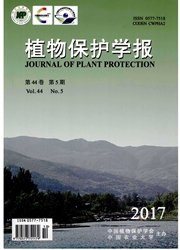

 中文摘要:
中文摘要:
从2004年开始,延边地区稻田大量发生抗磺酰脲类除草剂苄嘧磺隆的抗药性生态型雨久花。为解析其抗药性突变机制,采用离体法测定了抗、感性雨久花乙酰乳酸合成酶活性。结果表明,抑制抗、感性雨久花乙酰乳酸合成酶活性50%的苄嘧磺隆剂量为253.44×10^-7mol/L和2.80×10^-7mol/L;抑制抗、感性雨久花乙酰乳酸合成酶活性50%的吡嘧磺隆剂量为1802.15×10^-7mol/L和20.85×10^-7mol/L。抗药性雨久花对苄嘧磺隆和吡嘧磺隆的抗性系数(RI50/SI50)值分别为90.6和86.5,并存在交互抗药性。确认抗药性突变系由其乙酰乳酸合成酶对磺酰脲类除草剂苄嘧磺隆、吡嘧磺隆反应钝化所致。
 英文摘要:
英文摘要:
The resistant biotype of Monochoria korsakowii Regel et Maack to sulfonylurea(SU) has been found in the paddy fields of Yanbian Region since 2004. In order to study its mechanism of the herbicide- resistance, analytical method of in vitro was employed to evaluate the inhibitory effect of SU on the acetolactate synthases(ALS) in Monochoria korsakowii. The test results indicated that the 150 (herbicide concentrations required for 50% inhibition) of ALS specific activity to bensulfuron-methyl in resistant biotypes and susceptible biotype was 253.44 × 10^ -7 mol/L and 2.80 × 10^ -7 mol/L respectively, 150 of ALS specific activity to pyrazosulfuron-ethyl in resistant biotypes and susceptible biotype was 1 802.15 × 10^-7 mol/L and 20.85 × 10^-7 mol/L respectively. The resistance ratio of resistance biotype to bensulfuron- methyl was 90.6 and to pyruzasulfuron-ethyl was 86.5. There is cross resistance between bensulfuron-methyl and pyruzasulfuro-ethyl. It suggested that the ALS of SU-resistance biotype was dulled to SU herbicides.
 同期刊论文项目
同期刊论文项目
 同项目期刊论文
同项目期刊论文
 期刊信息
期刊信息
